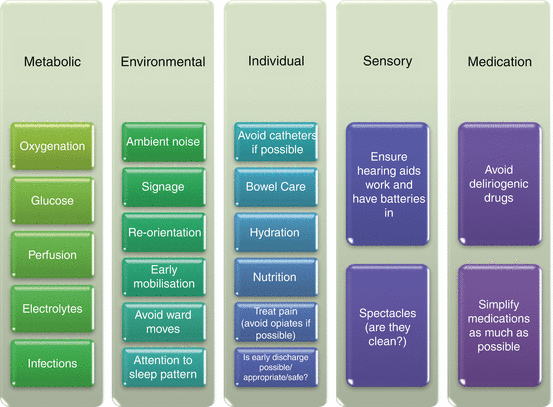Test
Time to complete
Training required?
Sensitivity (95% CIs) (%)
Specificity (95% CIs) (%)
AMT10
Minutes
Yes
86.6
63.5
AMT4
Seconds
No
92.7
53.7
MOTYB
Seconds
No
91.3
49.7
4AT
Minutes
Yes
86.7–89.7
69.5–84.1
SQiD
Seconds
No
91.4
61.3
DTS
Seconds
No
98.0
55.0
CAM
Minutes
Yes
94.0
89.0
bCAM
Minutes
Yes
70.3, 78.0–84.0
91.4, 95.8–96.9
The 4 As Test (4AT) [9] is a four-item assessment to identify individuals with the cardinal features of delirium. It includes an assessment of alertness, cognition (AMT4), attention (MOTYB) and acuity of onset/fluctuating course (arising within the last two weeks and still evident within the last 24 h). The 4AT can be completed in under 2 min and does not require specialist training. The sensitivity and specificity in English-/non-English-speaking patients are 89.7/84.1% and 91/71%, respectively. Validation studies for the emergency department are currently underway.
In contrast to the other screening tests for delirium, the brief CAM (bCAM) is a two-step screening tool, developed from the CAM and CAM-ICU instruments. It is designed to be used in the ED setting, with brevity as a core feature. It may therefore be helpful to identify from the patients with positive delirium screening questions. It is supposed to be used combined with the Delirium Triage Screen (spell the word ‘lunch’ backwards and/or the feature of altered level of consciousness). DTS has a very good negative likelihood ratio of 0.04 and the bCAM a positive likelihood ratio of 20.0 when used in series and can be easily used in the ED [10].
More formal diagnosis of delirium requires the criteria of the DSM to be met. Where some, but not all features are present, a sub-syndromal delirium may be present. Delirium diagnostic tools operationalise the DSM diagnostic criteria into algorithms (e.g. Confusion Assessment Method long form) or questionnaires (e.g. DRS-R-98) and are based on more lengthy interviews with patients and informants. Sensitivity of the CAM is dependent on the training of the user, and in untrained hands, sensitivity as low as 40% has been reported. The authors of the CAM [11] stress the importance of training in the use of the instrument according to the CAM manual. The requirement for specific training and the duration to administer these definitive delirium diagnostic assessments limit their feasibility in the ED setting.
13.8 Risk Factors for Delirium
There are several risk factors for the development of delirium. Some of these are fixed (e.g. coexisting dementia and frailty), whilst some are modifiable. Modifiable risk factors are highlighted in Fig. 13.1. Identification (and minimisation) of these may help to prevent an episode of delirium. Once delirium is established, there is no specific treatment other than identification and removal of the contributing factors.


Fig. 13.1
Modifiable risk factors for the development of delirium
Typically, predisposing non-modifiable factors (dementia, serious illness, frailty) interact with precipitating, modifiable factors (sedatives, infections, surgery, electrolyte abnormalities) for delirium to develop. The commonest risk factors for delirium include age 65 years or older (who constitute 50–60% of all non-ambulatory patients in typical EDs), cognitive impairment (past or present) and/or dementia, current hip fracture (10% present with delirium, with 16–62% incidence postoperatively) [12] and any severe illness (a clinical condition that is deteriorating or is at risk of deterioration). Other important precipitating agents for delirium include anticholinergic and antiparkinsonian drugs; inflammation from trauma, infection or surgery; any acute stress mediated by increased cortisol levels; hypoxia, hypoglycaemia, fluid, electrolyte and other metabolic derangements; and hypotension and hypothermia.
13.9 Management of Delirium
There are no ‘routine’ investigations for delirium in the ED, and based on a thorough history, collateral information, clinical presentation and physical examination, the following investigations may be employed as needed: haemoglobin, cell count and differential, urea, creatinine and electrolytes, bone profile, chest X-ray, urine dipstick and culture (can be helpful to exclude UTI—see Chap. 16) and CT brain (2–7% pickup rate for a significant neurological lesion) [13].
Once delirium has been detected, management is directed towards addressing the underlying precipitating factors as described in Fig. 13.1.
13.10 Prevention of Delirium in Those at Risk
The most important step in the ED to improve delirium recognition and management is to institute routine screening for the condition and support it by appropriate processes that prevent its development. For example, avoidance of benzodiazepines or anticholinergics may help prevent an episode of delirium in susceptible older people. Medicines with anticholinergic effects are a frequent cause of delirium in older people, and ‘anticholinergic burden’ is a good means of understanding this risk [14]. Other considerations such as maintaining orientation to surroundings, meeting needs for nutrition and fluids, promoting mobility within the limitations of physical condition and providing visual and hearing adaptations for patients with sensory impairments have been shown to reduce the incidence of delirium in hospital settings (Hospital Elder Life Programme; OR 0.6, CI 0.39–0.92) [15]. These principles could be applied as feasible in the ED although there are no related studies. Appropriate management of pain, constipation, retention of urine and avoiding ‘lines and tubes’ that restrict mobility also benefits the older person. Environmental considerations include noise insulation, natural lighting, sympathetic décor, signage and low trolley.
Stay updated, free articles. Join our Telegram channel

Full access? Get Clinical Tree





